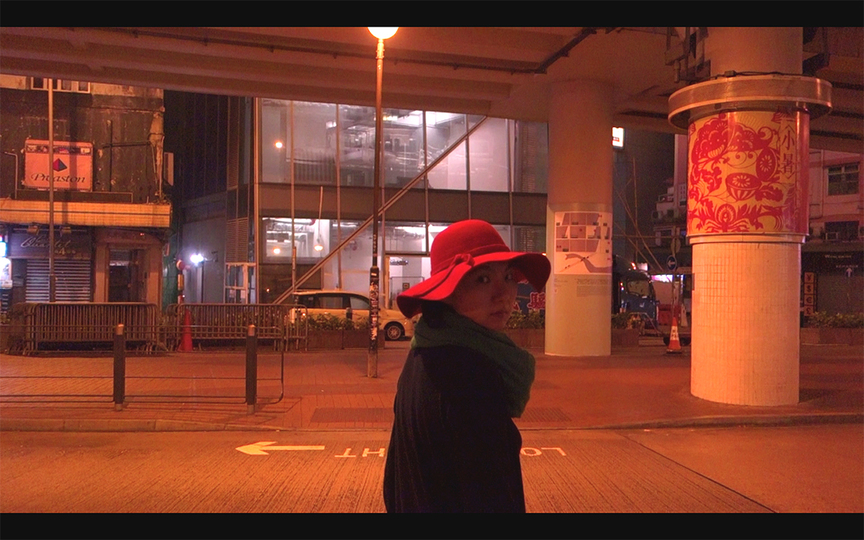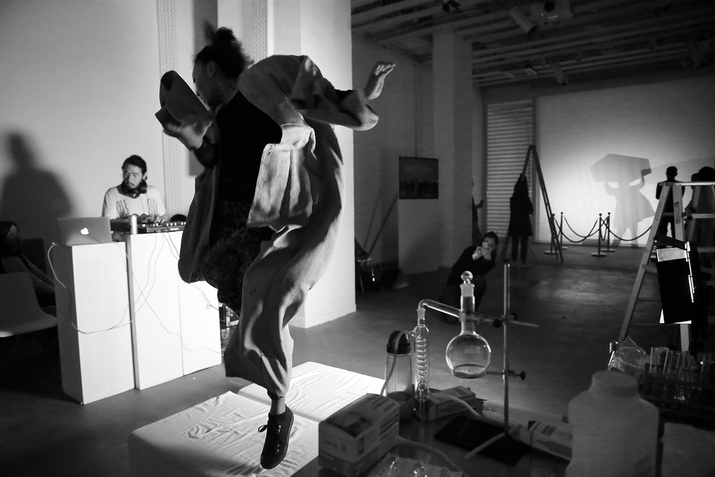
R
E
V N
E
X
T
It was March 22, 2016, opening night of Art Basel Hong Kong and the busiest week in the city’s art calendar. As colleagues flocked to the fair after work, I hurried in the opposite direction towards an obscure back alley in Causeway Bay. It took me ten minutes to arrive in the general vicinity and another ten minutes of wandering before I honed in on the exact address. “I have arrived, I think,” I texted Hong Kong-based artist and curator Enoch Cheng, staring sceptically at the deserted two-by-twelve-foot ground-floor storefront. Where was the promised exhibition, and what had I come to see?
The film installation I experienced that evening, one of my first encounters with Cheng’s developing body of work, began with his cryptic instruction “press play when you’re ready.” FearLess (2016), the result of the emerging artist’s six-month residency at independent Hong Kong art space A Walk With A3, was a 17-minute single-channel video projected onto the grubby wall opposite the storefront that launched upon command. An unassuming set-up transformed the space into an open-air, semi-private audience booth tucked away on the dark backstreet, while the film comprised extended hand-held night shots that furtively shadowed a red-hatted female protagonist through the streets of the surrounding area—the very streets through which I had only just roamed. The juxtaposition between real and virtual was elusive yet gripping: as I sat, headphones in place, alone in the booth that admitted only one audience member at a time, the fictional filmscapes coalesced with scenes from the journey that had led me to the work, while surrounding real-world sensations—the clamour of traffic, the flashing of car lights and reflected neon signs—leached into my film-induced reverie. The effect was uncanny and disorienting, negotiating a hypnotic balance between the eerie and the whimsical, evoking the disconcerting incongruence of a probing dream.
ENOCH CHENG, Same Boat, 2017, still from three-channel audio-visual installation: 19 min. Courtesy the artist.
Throughout the next year and a half, I became gradually more acquainted with Cheng’s wide-ranging creative practice that spans film, installation, dance, performance and curatorial work. Though the 33-year-old had only become active in the art scene on his own terms over the past two years—as for much of his twenties Cheng was a programme manager at Hong Kong’s Asia Art Archive—his presence is already conspicuous. Cheng recently curated the multi-dimensional exhibition “When Will I See You Again” at Hong Kong’s Oi!, which featured film installations by Cheng Ran, Erik Bünger and Cheng himself alongside performances by Ger Choi Tsz Kwan and Scarlet Yu. The ensemble was at once conceptual and experiential, revealing an organic curatorial process that wove together multiple strands of ideas, narratives and sensations. Cohering in their explorations of time, journey and liminal spaces, the varied works found an additional layer of resonance in the motif of man’s (real or imaginary) relationship with animals and nature, while separately coaxing out singular layers of perspectives.
Cheng’s own contribution, developed in parallel to the making of the exhibition, was a three-channel audio-visual installation entitled Same Boat (2017). Interlacing fiction, mythology, music and image, the bizarre yet compelling montage tells and un-tells the story of an unknown protagonist, which could be “an illegal immigrant, a zebra, or someone or something of the other,” as Cheng writes in his artist statement. The evocative sense of journey invoked by Same Boat entailed a personal pilgrimage on top of an artistic one: riding on the waves of soft drumbeats, the film takes us to South Africa where members of Cheng’s family reside. For the artist, the shooting of the film coincided with his setting foot again on South African soil for the first time in 20 years. The medley of scenes were drifting, lyrical and loosely structured, guided not by narrative but by entrancing cinematographic rhythms—haunting at times, teasing at others and constantly beckoning towards the unknown. In a particularly engrossing scene, a pig carcass twitches, spasms and leaps back and forth from its pile in a butcher house (belonging to Cheng’s uncle, a second generation migrant), almost as if it were dancing to jubilant disco beats.
The sequence is outlandish and oddly riveting, encapsulating a key aspect of Cheng’s visual language—the teasing out of universal themes via the pulses and flavours of everyday peculiarities and eccentricities. A subtle, quirky playfulness underlies all of Cheng’s works, though never flippantly. In “The Loss of a Yellow Striped Shirt,” a solo exhibition held at Wing Platform in 2017, the themes of loss, extinction and exile were explored through an immersive, multi-faceted installation swathed in soft pastel yellow hues. The gently whimsical ambiance conjured up a particular presence and personality for the concept of absence, inviting viewers to “slow down and become acquainted with the experience of losing something,” to loosely paraphrase Cheng. In GlabSpheellanoid (2016), a collaborative performance at Connecting Space, a choreographed pas de deux by professional dancers evolved into an impromptu routine, ultimately transmuting into a euphoric disco involving all members of the audience. The experimental event was the result of a conceptual interrogation on the relationship between artist and curator (roles which were represented by the original two dancers)—a framework that expanded to include dynamic negotiations with both audience and site.
Glabspheellanoid makes a powerful statement on the conditions of art-making that Cheng is concerned with; in many ways, Cheng approaches art-making as inseparable from exhibition-making, so central to his creative process are the unique temporal-spatial flows of each exhibition space. Going beyond the phrase “site-specific,” which still places the artwork at the centre, Cheng’s investigations echo that of French artists Pierre Huyghe and Philippe Parreno in treating the entire exhibition as a work in itself and the site as a key participating factor. Just as he would partake in discussions with artists while commissioning works, Cheng engages in extended negotiations with spaces: FearLess, for example, emerged from a sustained personal and collaborative rendezvous with the storefront and its vicinity—one that involved months of listening, observing, inhabiting and co-inhabiting. For an interim phase of the project, Cheng even invited different people into the space, engaging them in conversations about their experiences of the locale. For “When Will I See You Again,” Cheng likewise took the repurposed Oil Street venue as a point of departure, visiting it daily and feeding on its intersecting histories. Such efforts are indiscernible on the surface but contribute to his construction of multi-sensorial sites, where media interplays with memory, natural and technological systems interact and audiences’ movements and subjectivities become part-and-parcel of their viewing experiences.
Since 2015, Cheng has exhibited at institutions such as the Centre for Chinese Contemporary Art, Manchester, the Glasgow Centre for Contemporary Arts and the Hong Kong Museum of Art. He has undertaken residencies around the world, most recently at the Akademie Schloss Solitude in Stuttgart, Germany. Progressing on from previous preoccupations about time, memory and migration, Cheng’s current interests involve theories on natural history, biology and pre-Darwinian thought. Such research tendencies seem to have informed his upcoming exhibition presented by K11 Art Foundation, entitled “The Garden,” of which Cheng is again both curator and participating artist. Slated to encompass installations and time-based works made up of sound, video, performances and sculptures—media all very much within Cheng’s forte—one looks forward to yet another idiosyncratic and fertile experience. Press play when you’re ready, and enjoy the show.
To read more of ArtAsiaPacific’s articles, visit our Digital Library.










